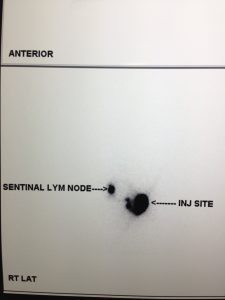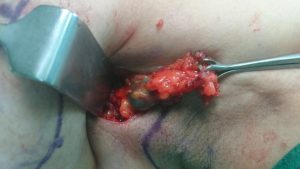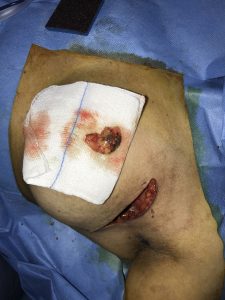


Sentinel Node Biopsy for Early Breast Cancer: Patients with early breast cancer without any palpable glands in the armpit may avoid complete axillary dissection by undergoing sentinel node biopsy. The sentinel node is defined as the first node in the armpit which may harbor any cancer cells. These patients are subjected to breast scintigraphy on the day of surgery after injecting radioactive Tc99 nano colloid in the breast behind the nipple. Gamma scan is performed in the nuclear medicine department after roughly two hours of injection and sentinel nodes are localized in the armpit. The patient is then shifted to the operation theatre and sentinel nodes are dissected by a small incision in the armpit. The suspicious axillary lymph nodes are sent for frozen section analyses, and if negative for cancer further compete for axillary clearance is not performed.
Dr Ashish Goel is the best cancer surgeon in Noida & talks about Sentinel Node Biopsy for Early Breast Cancer
Sentinel node biopsy is a surgical procedure performed to determine if breast cancer has spread to the lymph nodes. It is commonly used in the management of early-stage breast cancer.
The lymph nodes play a crucial role in the body’s immune system and are often the first site where cancer cells may spread from the primary tumor. Sentinel node biopsy helps identify the “sentinel nodes,” which are the first lymph nodes that cancer cells are likely to reach from the primary tumor.
Here’s how the procedure typically works:
- Injection of a tracer: Before surgery, a small amount of a radioactive substance or a blue dye is injected near the tumor site. The substance or dye flows through the lymphatic vessels and highlights the sentinel nodes.
- Identification of the sentinel nodes: During the surgery, the surgeon uses a handheld device to detect the radioactive substance or visually identifies the blue-stained lymph nodes. These are considered the sentinel nodes.
- Removal of sentinel nodes: The surgeon makes a small incision near the tumor site and carefully removes the identified sentinel nodes. Typically, 1 to 3 lymph nodes are removed. These nodes are then sent to the pathology laboratory for further examination.
- Pathology examination: In the laboratory, the sentinel nodes are carefully examined under a microscope. If no cancer cells are found, it suggests that the cancer has not spread to the lymph nodes. If cancer cells are detected, it indicates lymph node involvement, and further treatment decisions may be made based on the findings.
Sentinel node biopsy has several advantages over traditional axillary lymph node dissection, which involves the removal of a larger number of lymph nodes. It is a less invasive procedure, associated with a lower risk of complications such as lymphedema (swelling of the arm), shoulder stiffness, and sensory changes. It also allows for more targeted treatment since only the affected nodes are removed.
It’s important to note that sentinel node biopsy is not appropriate for all breast cancer cases. Factors such as tumor size, location, and other clinical features are considered to determine if a patient is a suitable candidate for this procedure. The decision to perform sentinel node biopsy is made based on the individual’s specific situation and in consultation with their healthcare team.
